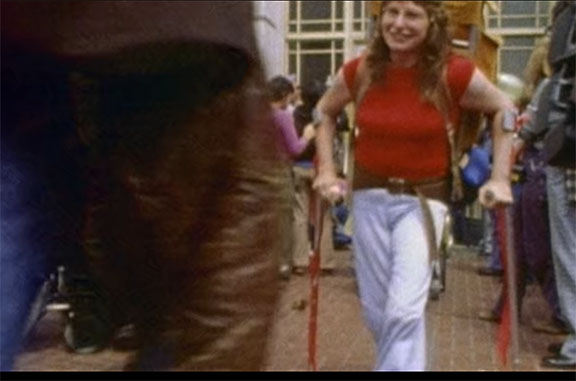
(photo from “Crip Camp:” Swami Suddhananda emerges from the “504 Sit-In,” 1977.)
For those who have heard about or seen the compelling Netflix documentary “Crip Camp: A Disability Revolution,” Yogaville’s own Swami Suddhananda (who has cerebral palsy) only appears briefly in it—but she figures more centrally in its main storyline. “Crip Camp” is a 2020 documentary film released under the banner of Barack and Michelle Obama’s Higher Ground Productions. The film follows a group of disabled youth from their summer camp experience in the early ‘70s, at Camp Jened, near Woodstock, New York, through their individual struggles to win equal rights and access for themselves, to their first collective efforts to establish and defend disability rights laws. It’s the true story of how a group of disabled people learned about themselves, explored the relationships between disability and society, and banded together to shape a different way of understanding disability.
The second half of Crip Camp traces the early history of the disability rights movement in the United States through five main stages:
- The disabled youth of Camp Jened individually confront the barriers they encounter as young adults.
- They reconnect and form a wider movement to establish the first federal disability rights law, Section 504 of the Rehabilitation Act of 1973.
- They fight again to get Section 504 regulations implemented.
- They fight back to protect these regulations from repeal.
- They fight once again, on a much larger scale, to pass a more ambitious and powerful disability rights law, the Americans with Disabilities Act of 1990.
The film has two emotional crescendos depicting key moments in the history of disability rights. One of these was the 1977 “504 Sit-In,” in which activists occupied federal buildings to push the Carter administration to adopt the long-delayed regulation. It is during scenes from the 504 Sit-In, that Swami Suddhananda, (at the time not a swami and prior to her involvement with Integral Yoga) is seen as she emerges victorious from the federal building after the sit-in.
As Swami Suddhananda explains in an interview with Parvathi Moore for Integral Yoga Magazine:
“I was locked in the Federal Building for 28 days, along with other demonstrators and my boyfriend, Jonathan, who was the personal care attendant to Hale Zucas, who was one of the organizers of the demonstration. Growing up, I experienced all the stigmas the people in the movie are talking about. Basically a “disabled” person is considered useless, a burden, shameful to the family, a child, no matter how old they are. It’s hard to talk about is the prejudice I experienced and continue to. Recently, when I was out in my wheelchair, a person I did not know came up and patted me on the head. Am I a golden retriever? Physically, sometimes men pick disabled women to sexually assault. We are considered weaker and of no consequence. That’s the prejudice we were protesting and that fueled the law we were advocating for.
“Those who are disabled are not considered part of society. Euthanasia was practiced until quite recently. Disabled babies were left in state hospitals. There were huge rooms filled with cribs of little babies. Many died. Those who survived grew up there, in the institution. Both my brother and I were recommended to be sent to such a place at birth. My mother refused.”
Not too long after the demonstration, Swami Suddhananda made her way to Satchidananda Ashram–Yogaville East in Connecticut where she met her Guru and started the journey that led her to further dedicate her life to spiritual pursuits and selfless service. She shared reflections about this other compelling part of her life story:
“I thought I was coming to the Ashram to learn to teach Yoga. That also happened, but when I met Swami Satchidananda (Gurudev), that is yet another great story. He said to me: ‘You are not the body.’ When he said that, I knew, from a deeper place than I had known before, that it was true. I had known before that the body was not my identity, but when he said it, I felt completely free. Of course, Gurudev never treated me any differently because of my body. He was one of a handful of able-bodied people I could say that about.
“In the movie, I think it was Judy Heumann who talked about always having to fight to be part of life. When I met Gurudev, something in me relaxed. I didn’t need to fight anymore. I had a Guru on my side. It was like letting out a breath you didn’t know you were holding in.”
What an incredible journey and inspiration…

